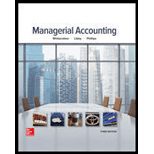
Concept explainers
(a)
Concept introduction:
Fixed overhead rate variances:
It is calculated by dividing fixed manufacturing overhead with practical capacity of the company.
To compute:
The fixed overhead rate based on practical capacity.
(b)
Concept introduction:
Fixed overhead spending variances:
It is the difference between ‘budgeted fixed overhead’ and ‘actual fixed overhead’.
To compute:
The fixed overhead spending variances of HMC.
(c)
Concept introduction:
Expected (planned) capacity variance:
It is the difference between budgeted volume and practical capacity multiplied with fixed overhead rate.
To compute:
TheExpected (planned) capacity variance of HMC.
(d)
Concept introduction:
Unexpected (unplanned) capacity variance:
It is the difference between actual volume and budgeted volume multiplied with fixed overhead rate.
To compute:
Theunexpected (unplanned) capacity variance of HMC.
(e)
Concept introduction:
Fixed overhead spending variances:
It is the difference between budgeted fixed overhead and actual fixed overhead.
Fixed overhead volume variance:
It is the difference between actual volume and budgeted volume multiplied with fixed overhead rate.
Whether fixed manufacturing overhead is over or under applied.
Want to see the full answer?
Check out a sample textbook solution
Chapter 9 Solutions
Managerial Accounting
- During April, Harrison Manufacturing incurred the following costs on Job 210 for the manufacture of 250 engines:arrow_forwardSwinton Furnishings makes tables and planned to sell 3,800 tables in its master budget for the coming year. The budgeted selling price is $40 per table, variable costs are $20 per table, and budgeted fixed costs are $50,000 per month. At the end of the year, it was determined that Swinton actually sold 4,100 tables for $158,000. Total variable costs were $56,500 and fixed costs were $42,000. The volume variance for sales revenue was: A. $12,000 favorable B. $15,000 unfavorable C. $16,000 favorable D. $11,500 favorablearrow_forwardCan you explain the process for solving this financial accounting question accurately?arrow_forward
- Blunt Industries estimates an allocation base of 45,500 machine hours and an estimated total manufacturing overhead cost of $109,200. What is the predetermined overhead rate to be applied to the jobs?arrow_forwardgeneral accountingarrow_forwardUnder Armour Manufacturing's standard materials cost per unit of output is $12.96 (2.40 pounds × $5.40). During August, the company purchases and uses 3,400 pounds of materials costing $18,530 in making 1,500 units of the finished product. Compute the total, price, and quantity materials variances.arrow_forward
- Can you help me solve this general accounting question using the correct accounting procedures?arrow_forwardChevrolet Creative Agency applies overhead to jobs based on direct professional labor hours. Overhead was estimated to be $248,000, direct professional labor hours were estimated at 31,000, and direct labor cost was projected to be $460,000. During the year, Chevrolet incurred actual overhead costs of $230,500, actual direct professional labor hours of 26,500, and actual direct labor costs of $395,000. By year-end, the firm's overhead was __.arrow_forwardI need help solving this general accounting question with the proper methodology.arrow_forward
 Cornerstones of Cost Management (Cornerstones Ser...AccountingISBN:9781305970663Author:Don R. Hansen, Maryanne M. MowenPublisher:Cengage Learning
Cornerstones of Cost Management (Cornerstones Ser...AccountingISBN:9781305970663Author:Don R. Hansen, Maryanne M. MowenPublisher:Cengage Learning Principles of Cost AccountingAccountingISBN:9781305087408Author:Edward J. Vanderbeck, Maria R. MitchellPublisher:Cengage LearningPrinciples of Accounting Volume 2AccountingISBN:9781947172609Author:OpenStaxPublisher:OpenStax College
Principles of Cost AccountingAccountingISBN:9781305087408Author:Edward J. Vanderbeck, Maria R. MitchellPublisher:Cengage LearningPrinciples of Accounting Volume 2AccountingISBN:9781947172609Author:OpenStaxPublisher:OpenStax College Managerial AccountingAccountingISBN:9781337912020Author:Carl Warren, Ph.d. Cma William B. TaylerPublisher:South-Western College Pub
Managerial AccountingAccountingISBN:9781337912020Author:Carl Warren, Ph.d. Cma William B. TaylerPublisher:South-Western College Pub Financial And Managerial AccountingAccountingISBN:9781337902663Author:WARREN, Carl S.Publisher:Cengage Learning,
Financial And Managerial AccountingAccountingISBN:9781337902663Author:WARREN, Carl S.Publisher:Cengage Learning, Managerial Accounting: The Cornerstone of Busines...AccountingISBN:9781337115773Author:Maryanne M. Mowen, Don R. Hansen, Dan L. HeitgerPublisher:Cengage Learning
Managerial Accounting: The Cornerstone of Busines...AccountingISBN:9781337115773Author:Maryanne M. Mowen, Don R. Hansen, Dan L. HeitgerPublisher:Cengage Learning





